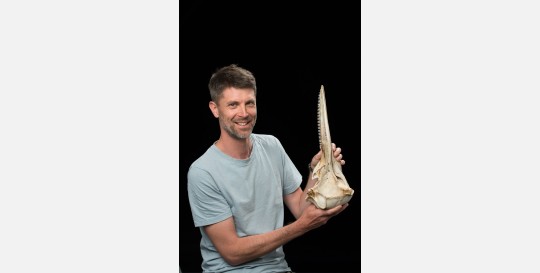Olivier Lambert
Palaeontologist
Palaeobiosphere Evolution
Earth and History of life

Olivier Lambert is a palaeontologist investigating various aspects of the return to an aquatic environment in marine tetrapods. Focusing especially on the evolution of cetaceans, his main sources of fossils are the area of Antwerp (Belgium) and the Pisco Basin (Peru).
Function
Since 2013, Olivier works as a permanent researcher in vertebrate palaeontology at the Royal Belgian Institute of Natural Sciences (RBINS). His scientific collaborations include the study of fossil cetaceans from many areas of the world, with a special emphasis on the Neogene of the North Sea and the Paleogene and Neogene of the southeastern Pacific.
Research team: Palaeobiosphere Evolution unit
Research theme: Evolution and the Web of Life
Ecosystems over time
Area of Expertise
To investigate the evolution of cetaceans and other marine tetrapods, Olivier's research includes palaeontological fieldwork and collection studies. His main fields of expertise are systematics, taxonomy, phylogeny, functional morphology, palaeoecology and taphonomy.
Professional Experience
Before being hired as a permanent staff of the RBINS, Olivier studied geology at the UCLouvain, then undertook a PhD thesis on the cetaceans from the Miocene of the southern North Sea at the ULB/RBINS, followed by several postdocs at the RBINS and Muséum national d'Histoire naturelle (Paris).
Dissemination activities
The jaws of the Leviathan by Nature Video
Four-legged whale ancestors reached South America in an otter-like swimming style
Ancient Whale Could Be Heaviest Animal Ever
Publication highlights
Lambert, O., Bianucci, G., Post, K., de Muizon, C., Salas-Gismondi, R., Urbina, M. & Reumer, J., 2010. The giant bite of a new raptorial sperm whale from the Miocene epoch of Peru. Nature, 466(7302): 105-108.
Lambert, O., Martínez-Cáceres, M., Bianucci, G., Di Celma, C., Salas-Gismondi, R., Steurbaut, E., Urbina, M. & Muizon, C. de, 2017. Earliest mysticete from the late Eocene of Peru sheds new light on the origin of baleen whales. Current Biology, 27(10): 1535-1541.
Lambert, O., Bianucci, G., Salas-Gismondi, R., Di Celma, C., Steurbaut, E., Urbina, M., & Muizon, C. de, 2019. An amphibious whale from the middle Eocene of Peru reveals early South Pacific dispersal of quadrupedal cetaceans. Current Biology, 29(8): 1352-1359.
Godfrey, S. J. & Lambert, O., 2023. Miocene toothed whales (Odontoceti) from Calvert Cliffs, Atlantic Coastal Plain, U.S.A. Smithsonian Contributions to Paleobiology, 107: 49-186.
Bianucci, G., Lambert, O., Urbina, M., Merella, M., Collareta, A., Bennion, R., Salas-Gismondi, R., Benites-Palomino, A., Post, K., Muizon, C. de, Bosio, G., Di Celma, C., Malinverno, E., Pierantoni, P. P., Villa, I. M. & Amson, E., 2023. A heavyweight early whale pushes the boundaries of vertebrate morphology. Nature, 620: 824-829.


